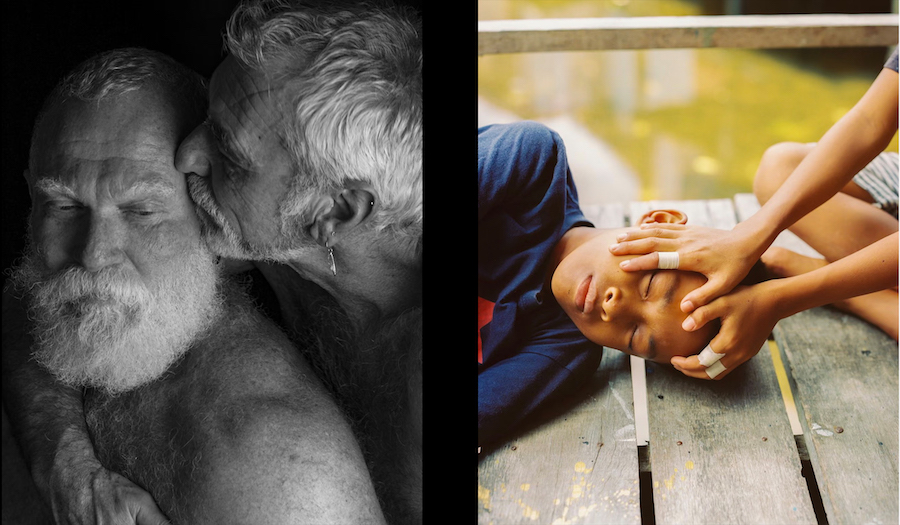The Taylor Wessing Photo Portrait Prize has a knack for capturing the human condition at its most unguarded. This year’s winner, Swedish photographer Martina Holmberg, does just that with Mel — a portrait that refuses sentimentality yet brims with compassion. It’s the kind of image that lingers. A woman bathed in cool light, her repaired skin catching the window’s reflection, looked somewhere far beyond the frame. Holmberg calls her series “The Outside of the Inside” — an exploration of people whose faces and bodies deviate from what society considers “normal.” Mel is a burn survivor. Her sister didn’t make it. The photograph, quiet as breath, doesn’t ask for pity; it offers witness.
Holmberg, a freelance photographer and writer from Stockholm, grew up watching her father develop prints in a darkroom — the kind of origin story that still makes sense when you see her work: intimate, human, full of empathy. The judges praised Mel for its balance of technical precision and emotional restraint. It earned her £15,000 and a place in the history of a prize known for steering contemporary portraiture toward depth rather than gloss.

Second place went to Luan Davide Grey for We Dare to Hug, a black-and-white portrait that makes tenderness between two older men look like sculpture. The pair, in their 60s, hold one another gently, an image so simple it stuns. It’s part of Grey’s series Call Me by Your Name — not a film homage, but a human one. “Love is love regardless of form,” Grey insists. The photograph, cropped tight and flooded with shadow, captures that message without needing to say it.
Byron Mohammad Hamzah took third prize for Jaidi Playing, a portrait born out of documentary work in East Malaysia. Hamzah, an NHS consultant and photographer, has been volunteering with stateless Bajau Laut children. In this portrait, Jaidi’s head rests in another child’s hands, a moment of play that feels almost sacred against a backdrop of political invisibility. The judges admired its tenderness — and the way it leaves questions hanging in the silence around it.
The Taylor Wessing Photographic Commission, worth £8,000, went to Hollie Fernando for her lush, folkloric Boss Morris. Her subjects — an all-female Morris dancing group from Stroud — stand huddled, faces streaked with wildflowers, their white dresses glowing in solstice light. The result is dreamlike, somewhere between Pre-Raphaelite reverie and modern sisterhood. It’s part of Fernando’s Hoydenish series, celebrating women reclaiming traditions once reserved for men. The judges called it “mysterious and compelling,” an image alive with layered storytelling.
A new addition to the exhibition this year is a portrait of activist Lady Phyll (Phyllis Akua Opoku-Gyimah), co-founder of UK Black Pride, taken by last year’s commission winner Jesse Navarre Vos. It’s a striking collaboration between sitter and artist. Lady Phyll is draped in a family kente cloth, surrounded by dark flowers — a nod to both mourning and power. The portrait was shot at Home House, a Georgian townhouse transformed into an inclusive members’ club. Every element — from the Catalpa seed pods in her headdress to the calm in her gaze — feels earned, deliberate, and deeply symbolic.
“Through the contributions of so many remarkable photographers, we can continue to champion contemporary portraiture,” said Sabina Jaskot-Gill, Senior Curator of Photography at the National Portrait Gallery, which hosts the exhibition. The exhibition opens on 13 November 2025 at the National Portrait Gallery and runs until 8 February 2026, before touring to Sheffield’s Millennium Gallery in the spring of 2026.
This year’s judges — Sunil Gupta, Katy Hessel, Sabina Jaskot-Gill, and Tim Walker — sifted through 5,910 entries from 2,054 photographers across 51 countries, eventually selecting 54 works by 51 photographers. Their rigorous selection process ensures that the winning photographs truly represent the best of contemporary portraiture.
The Taylor Wessing Prize, in partnership with the National Portrait Gallery, remains one of the few major awards that takes the emotional possibilities of photography seriously. It’s not about glamour; it’s about looking — really looking. This commitment to the art form is a source of inspiration and appreciation for the power of photography to capture the essence of the human experience.
What ties these images together is not just technical brilliance, but a shared refusal to detach. Holmberg’s burn survivor, Grey’s lovers, Hamzah’s stateless child, Fernando’s dancers — all are caught mid-breath in the act of being seen. In an age obsessed with filters and self-curation, these portraits restore something rare: the fragile dignity of being real, and the profound emotional connection that comes with it.
The Taylor Wessing Photo Portrait Prize 2025 isn’t just a celebration of photographers; it’s a reminder that portraiture, at its best, remains the most direct form of empathy we have.
Exhibiting photographers
Ed Alcock, Catherine Hyland, Soulla Petrou, Todd Antony, Lou Jasmine, Joel Redman, Charli Baker, Ciril Jazbec, Steve Reeves, Timon Benson, Greg Kahn, Margaux Revol, Jonathan Bloom, JJ Keith, Marc Sethi, Harry Borden, Chan Yang Kim, Willian Sheepskin, Ashley Bourne, Pip Jay, King, Agata Szymanowicz, Olly Burn, Juliet Klottrup, Anastasia Taylor-Lind, Jeremy Chih-Hao Chuang, Mark Lamb, David Vintiner, Giles Duley, Rory Langdon-Down, Tamsyn Warde, Francesco Fantini, Roman Manfredi, Irina Werning, Hollie Fernando, Dora Mois, Dominic Whisson, Camilla Greenwell, Daisy Moseley, Roj Whitelock, Luan Davide Grey, Chris O’Donovan, Elena Bianca Zagari, Byron Mohammad Hamzah, Iyesogie Ogieriakhi, Mattia Zoppellaro, Martina Holmberg, Betty Oxlade-Martin, Debra Hurford Brown, Christopher Owens, Mahtab Hussain, Tom Parker.

